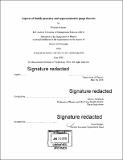| dc.contributor.advisor | Barton Zwiebach. | en_US |
| dc.contributor.author | Naseer, Usman | en_US |
| dc.contributor.other | Massachusetts Institute of Technology. Department of Physics. | en_US |
| dc.date.accessioned | 2018-11-15T16:36:56Z | |
| dc.date.available | 2018-11-15T16:36:56Z | |
| dc.date.copyright | 2018 | en_US |
| dc.date.issued | 2018 | en_US |
| dc.identifier.uri | http://hdl.handle.net/1721.1/119109 | |
| dc.description | Thesis: Ph. D., Massachusetts Institute of Technology, Department of Physics, 2018. | en_US |
| dc.description | Cataloged from PDF version of thesis. | en_US |
| dc.description | Includes bibliographical references (pages 145-149). | en_US |
| dc.description.abstract | This thesis explores aspects of gravity and quantum field theory (QFT). The first part is devoted to the interplay between manifest T-duality symmetry and higher-derivative corrections to the low-energy effective action of string theory. The second part focuses on exact results in supersymmetric gauge theories. We first discuss T-duality symmetry of string theory from various perspectives. We next review the manifest-duality-symmetric formulation of low-energy effective actions: double field theory (DFT) and its higher-derivative generalization, HSZ (Hohm-Siegel-Zwiebach) theory. We then compute on-shell three-point amplitudes in the HSZ theory. We show that these amplitudes factorize, as in bosonic and heterotic string theories, but they differ from both. Further, we analyze degrees of freedom in the HSZ theory. The spectrum of the theory contains massive spin-2 ghosts and massive scalars, in addition to massless fields. The massive modes can be integrated out exactly at the quadratic level, leading to an infinite series of higher-derivative corrections. Finally, we give a ghost-free massive extension of linearized DFT, which employs novel mass terms for the dilaton and the graviton. In the second part, we start by reviewing the exact results for partition functions of supersymmetric gauge theories on spheres. Exact results, however, are not available for minimally supersymmetric theories on S⁴ and S⁶. Minahan conjectured the form of perturbative partition functions for theories on Sd with eight and sixteen supersymmetries. We show that this form gives the correct one-loop divergences of the flat-space super Yang-Mills (SYM) upon taking the radius of the sphere to infinity. We also prove the conjecture explicitly for theories with eight supersymmetries. Further, we extend our results to theories with four supersymmetries for d < 4. We then propose an analytic continuation to d = 4 to obtain the partition function for a certain N = 1-preserving mass deformation of N = 4 SYM. This analytic continuation gives the correct /-function and agrees with the result for free vector and chiral multiplets. | en_US |
| dc.description.statementofresponsibility | by Usman Naseer. | en_US |
| dc.format.extent | 149 pages | en_US |
| dc.language.iso | eng | en_US |
| dc.publisher | Massachusetts Institute of Technology | en_US |
| dc.rights | MIT theses are protected by copyright. They may be viewed, downloaded, or printed from this source but further reproduction or distribution in any format is prohibited without written permission. | en_US |
| dc.rights.uri | http://dspace.mit.edu/handle/1721.1/7582 | en_US |
| dc.subject | Physics. | en_US |
| dc.title | Aspects of double geometry and supersymmetric gauge theories | en_US |
| dc.type | Thesis | en_US |
| dc.description.degree | Ph. D. | en_US |
| dc.contributor.department | Massachusetts Institute of Technology. Department of Physics | |
| dc.identifier.oclc | 1059576384 | en_US |
